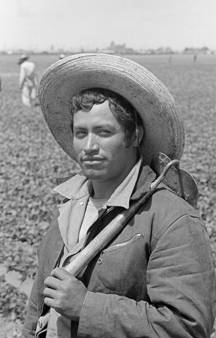


FEBRUARY 25 – APRIL 29, 2011
BITTERSWEET HARVEST: The Bracero Program 1942–1964
The Bracero Program was a guest worker initiative created by President Franklin Roosevelt that spanned the years 1942–1964 when millions of Mexican agricultural workers crossed the border to work in more than half of the states in America. The Wittliff Collections and the Public History Program at Texas State University-San Marcos co-present this traveling banner exhibition developed by the Smithsonian, which explores the braceros’ contributions to communities in Mexico and the United States, the opportunities that became available to them, and the challenges they faced as guest workers during the war years and afterward. The bilingual exhibition is comprised of 15 freestanding banners featuring oral histories, quotes, and images by photojournalist Leonard Nadel, whose photographs inspired the Smithsonian’s work on Bittersweet Harvest. Bittersweet Harvest: The Bracero Program 1942–1964 was developed by the Smithsonian’s National Museum of American History and circulated by the Smithsonian Institution Traveling Exhibition Service, with Federal support from the Latino Initiatives Pool administered by the Smithsonian Latino Center. More information, including a link to the Bracero History Archive, is available online.
[above] Bracero in the field, © 1956 by Leonard Nadel, courtesy of the Smithsonian National Museum of American History | Bracero is a term used in Mexico for a manual laborer. Between 1942 and 1964, an estimated two million Mexican men came to the United States on short-term labor contracts to help fill the labor shortages on farms and railroads caused by World War II. This bracero in Salinas, California, holds a short-handled hoe.
- Facebook
- Twitter
- Instagram
- Youtube
Email List